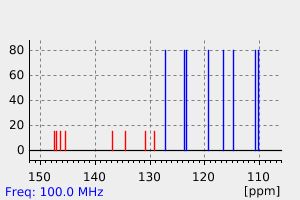6,7-dihydroxy-2-(3',4'-dihydroxyphenyl)naphthalene
中文名称
——
中文别名
——
英文名称
6,7-dihydroxy-2-(3',4'-dihydroxyphenyl)naphthalene
英文别名
6-(3,4-Dihydroxyphenyl)naphthalene-2,3-diol
CAS
——
化学式
C16H12O4
mdl
——
分子量
268.269
InChiKey
RHRGPVYNLSTBIN-UHFFFAOYSA-N
BEILSTEIN
——
EINECS
——
-
物化性质
-
计算性质
-
ADMET
-
安全信息
-
SDS
-
制备方法与用途
-
上下游信息
-
文献信息
-
表征谱图
-
同类化合物
-
相关功能分类
-
相关结构分类
计算性质
-
辛醇/水分配系数(LogP):3.4
-
重原子数:20
-
可旋转键数:1
-
环数:3.0
-
sp3杂化的碳原子比例:0.0
-
拓扑面积:80.9
-
氢给体数:4
-
氢受体数:4
上下游信息
-
上游原料
中文名称 英文名称 CAS号 化学式 分子量 —— 2-(3',4'-dimethoxyphenyl)-6,7-dimethoxynaphthalene 19611-17-7 C20H20O4 324.376
反应信息
-
作为产物:描述:(3,4-二甲氧基苯基)乙醛 在 盐酸 、 三溴化硼 作用下, 以 1,4-二氧六环 为溶剂, 生成 6,7-dihydroxy-2-(3',4'-dihydroxyphenyl)naphthalene参考文献:名称:大麻素与三溴化硼的反应摘要:用三溴化硼处理芳基乙醛1,可得到2-苯基萘2或1,2,9,10-四氢-1,9-环氧二苯并[a,e]环辛烯3通过串联的羟醛缩合-分子内Friedel-Crafts环化反应或缩合反应得到。在O-位置分别进行两次Friedel-Crafts烷基化。在所有情况下,都会发生甲氧基的完全脱甲基。DOI:10.1016/s0040-4039(98)01895-4
文献信息
-
Structure-Activity Relationship of Synthetic 2-Phenylnaphthalenes with Hydroxyl Groups that Inhibit Proliferation and Induce Apoptosis of MCF-7 Cancer Cells作者:Chi-Fen Chang、Ci-Yi Ke、Yang-Chang Wu、Ta-Hsien ChuangDOI:10.1371/journal.pone.0141184日期:——In this study, six 2-phenylnaphthalenes with hydroxyl groups were synthesized in high yields by the demethylation of the corresponding methoxy-2-phenylnaphthalenes, and one 2-phenylnaphthalene with an amino group was obtained by hydrogenation. All of the 2-phenylnaphthalene derivatives were evaluated for cytotoxicity, and the structure-activity relationship (SAR) against human breast cancer (MCF-7) cells was also determined. The SAR results revealed that cytotoxicity was markedly promoted by the hydroxyl group at the C-7 position of the naphthalene ring. The introduction of hydroxyl groups at the C-6 position of the naphthalene ring and the C-4' position of the phenyl ring fairly enhanced cytotoxicity, but the introduction of a hydroxyl group at the C-3' position of the phenyl ring slightly decreased cytotoxicity. Overall, 6,7-dihydroxy-2-(4'-hydroxyphenyl)naphthalene (PNAP-6h) exhibited the best cytotoxicity, with an IC50 value of 4.8 μM against the MCF-7 cell line, and showed low toxicity toward normal human mammary epithelial cells (MCF-10A). PNAP-6h led to cell arrest at the S phase, most likely due to increasing levels of p21 and p27 and decreasing levels of cyclin D1, CDK4, cyclin E, and CDK2. In addition, PNAP-6h decreased CDK1 and cyclin B1 expression, most likely leading to G2/M arrest, and induced morphological changes, such as nuclear shrinkage, nuclear fragmentation, and nuclear hypercondensation, as observed by Hoechst 33342 staining. PNAP-6h induced apoptosis, most likely by the promotion of Fas expression, increased PARP activity, caspase-7, caspase-8, and caspase-9 expression, the Bax/Bcl-2 ratio, and the phosphorylation of p38, and decreased the phosphorylation of ERK. This study provides the first demonstration of the cytotoxicity of PNAPs against MCF-7 cells and elucidates the mechanism underlying PNAP-induced cytotoxicity.本研究通过相应的甲氧基-2-苯基萘的去甲基化高产率合成了六种带有羟基的2-苯基萘,并通过氢化得到了一种带有氨基的2-苯基萘。评估了所有 2-苯基萘衍生物的细胞毒性,并测定了针对人乳腺癌 (MCF-7) 细胞的构效关系 (SAR)。 SAR结果表明,萘环C-7位上的羟基显着增强了细胞毒性。萘环C-6位和苯环C-4'位羟基的引入相当增强了细胞毒性,但苯环C-3'位羟基的引入略有降低细胞毒性。总体而言,6,7-二羟基-2-(4'-羟苯基)萘(PNAP-6h)表现出最好的细胞毒性,对MCF-7细胞系的IC50值为4.8 μM,对正常人乳腺表现出较低的毒性上皮细胞(MCF-10A)。 PNAP-6h 导致细胞停滞在 S 期,很可能是由于 p21 和 p27 水平增加以及细胞周期蛋白 D1、CDK4、细胞周期蛋白 E 和 CDK2 水平降低。此外,PNAP-6h 降低了 CDK1 和细胞周期蛋白 B1 的表达,很可能导致 G2/M 期停滞,并诱导形态学变化,如核收缩、核碎裂和核高浓缩,如 Hoechst 33342 染色所观察到的。 PNAP-6h 诱导细胞凋亡,最有可能是通过促进 Fas 表达、增加 PARP 活性、caspase-7、caspase-8 和 caspase-9 表达、Bax/Bcl-2 比率和 p38 磷酸化,并降低ERK 磷酸化。这项研究首次证明了 PNAP 对 MCF-7 细胞的细胞毒性,并阐明了 PNAP 诱导细胞毒性的机制。
-
一种绿色、简便的6-(3,4-二羟基苯基)-2,3-萘二醇制备方法
-
New 2-arylnaphthalenediols and triol inhibitors of HIV-1 integrase—Discovery of a new polyhydroxylated antiviral agent作者:Cédric Maurin、Cédric Lion、Fabrice Bailly、Nadia Touati、Hervé Vezin、Gladys Mbemba、Jean François Mouscadet、Zeger Debyser、Myriam Witvrouw、Philippe CotelleDOI:10.1016/j.bmc.2010.05.059日期:2010.7A series of 13 hydroxylated 2-arylnaphthalenes have been synthesized and evaluated as HIV-1 integrase inhibitors. 7-(3,4,5-Trihydroxyphenyl) naphthalene-1,2,3-triol 1c revealed chemical instability upon storage, leading to the isolation of a dimer 5c which was also tested. In the 2-arylnaphthalene series, all compounds were active against HIV-1 IN with IC50' s within the 1-10 lM range, except for 1c and 5c which displayed submicromolar activity. Antiviral activity against HIV-1 replication was measured on 1b-c and 5c. Amongst the tested molecules, only 5c was found to present antiviral properties with a low cytotoxicity on two different cell lines. (C) 2010 Elsevier Ltd. All rights reserved.
-
POLYMERIZABLE COMPOUND, POLYMERIZABLE COMPOSITION AND LIQUID CRYSTAL DISPLAY DEVICE申请人:JNC CORPORATION公开号:US20150102259A1公开(公告)日:2015-04-16An object is to provide a liquid crystal compound having high polymerization reactivity, a high conversion ratio and high solubility in a liquid crystal composition, a polymerizable composition containing the compound, a liquid crystal composite prepared using the composition, and a liquid crystal display device having the composite. A solution is a polymerizable compound represented by formula (1). In formula (1), P 1 and P 2 are identically group (P-1), (P-2) or (P-3), and in formula (P-1), M is hydrogen, fluorine, —CH 3 or —CF 3 ; S 1 and S 2 are a single bond, alkylene having 1 to 6 carbons or the like; a1, a2 and b1 are 0, 1, 2, 3 or 4, and a sum of al and a2 is 4; ring A 1 is naphthalene, anthracene or phenanthrene; and ring A 2 is cyclohexyl, phenyl, naphthyl, anthracenyl or phenanthrenyl; and Z 1 is a single bond, —CO—, —COO— or the like.
-
US9394482B2申请人:——公开号:US9394482B2公开(公告)日:2016-07-19
表征谱图
-
氢谱1HNMR
-
质谱MS
-
碳谱13CNMR
-
红外IR
-
拉曼Raman
-
峰位数据
-
峰位匹配
-
表征信息
同类化合物
(S)-溴烯醇内酯
(R)-3,3''-双([[1,1''-联苯]-4-基)-[1,1''-联萘]-2,2''-二醇
(3S,3aR)-2-(3-氯-4-氰基苯基)-3-环戊基-3,3a,4,5-四氢-2H-苯并[g]吲唑-7-羧酸
(3R,3’’R,4S,4’’S,11bS,11’’bS)-(+)-4,4’’-二叔丁基-4,4’’,5,5’’-四氢-3,3’’-联-3H-二萘酚[2,1-c:1’’,2’’-e]膦(S)-BINAPINE
(11bS)-2,6-双(3,5-二甲基苯基)-4-羟基-4-氧化物-萘并[2,1-d:1'',2''-f][1,3,2]二氧磷
(11bS)-2,6-双(3,5-二氯苯基)-4羟基-4-氧-二萘并[2,1-d:1'',2''-f][1,3,2]二氧磷杂七环
(11bR)-2,6-双[3,5-双(1,1-二甲基乙基)苯基]-4-羟基-4-氧化物-二萘并[2,1-d:1'',2''-f][1,3,2]二氧杂磷平
黄胺酸
马兜铃对酮
马休黄钠盐一水合物
马休黄
食品黄6号
食品红40铝盐色淀
飞龙掌血香豆醌
颜料黄101
颜料红70
颜料红63
颜料红53:3
颜料红5
颜料红48单钠盐
颜料红48:2
颜料红4
颜料红261
颜料红258
颜料红220
颜料红22
颜料红214
颜料红2
颜料红19
颜料红185
颜料红184
颜料红170
颜料红148
颜料红147
颜料红146
颜料红119
颜料红114
颜料红 9
颜料红 21
颜料橙7
颜料橙46
颜料橙38
颜料橙3
颜料橙22
颜料橙2
颜料橙17
颜料橙 5
颜料棕1
顺式-阿托伐醌-d5
雄甾烷-3,17-二酮







